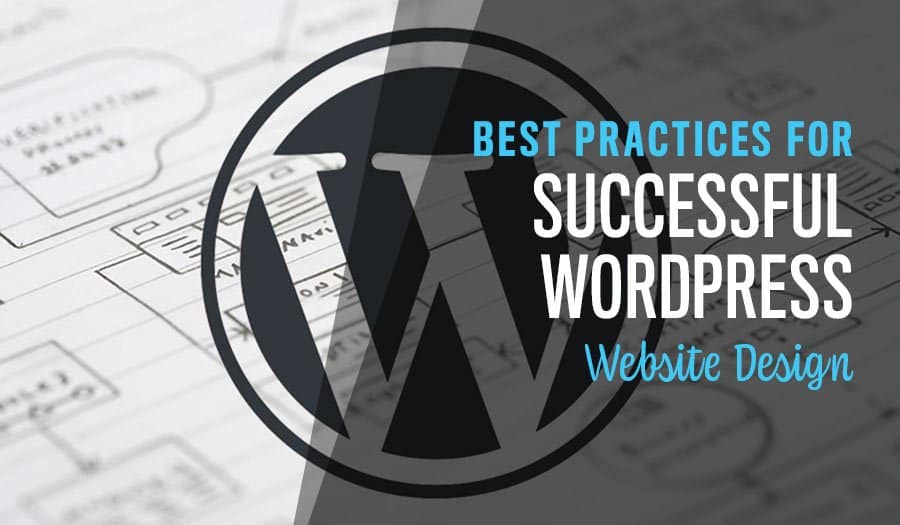There are a few simple steps to successful WordPress website design that WordPress developers should master to ensure an impeccable layout. Here are 8 Successful WordPress Website Design Best Practices
You are not alone if, like other WordPress developers, you would instead turn your attention to the code you love rather than pay attention to the design details of your layout. However, design is a necessary part of every successful web development project.
8 Successful WordPress Website Design Best Practices
By simply adopting the following best practices in WordPress website design, you can lessen your design dilemma:
1. Be Trendy.
Keeping up with all the ‘hot’ new design trends is not as hard as you think. You have probably already noticed the current ‘slick new tricks’ in web design in your day-to-day web browsing, even if you aren’t consciously looking out for them. It is worth the extra effort to investigate key design trends to ensure you stay current.
Near the top of today’s list of most popular trends would have to be parallax scrolling. This motion design technique is when images in the foreground move faster than those in the background. The effect is simple, effective and eye-catching. Parallax scrolling gives depth to your page’s design, adding visual interest. What’s better is that it is easy to implement and will focus users on your headlines.
Parallax is just one of the many developments that underscore the scroll-heavy emphasis of many current design trends. Although somewhat controversial, infinite scrolling is another hip technique. While it’s a blessing as it removes the need to constantly click “Next” to move on to the next page, infinite scrolling can also be a rabbit-warren-style curse if misused.
Material design is a current trend worthy of your consideration: it aims to ensure users have a seamless design experience across all platforms, focusing on mobile-first.
A current trend when it comes to stylish visual displays of condensed information is card-based design (think Pinterest). It is understandably popular due to how it creates high-impact visual engagement.
Key takeaway: you will up your design sensibility and marketable skillset by intentionally taking a little time to explore major current design trends.
2. Remember, size does matter.
There’s little more frustrating than an app or website that doesn’t function properly across all platforms or perform on all screen sizes: up to a third of website traffic can be lost by overlooking this one crucial design element. As a developer, you know it often isn’t an easy fix, but you also know that if your design doesn’t adjust to your user’s screen size, platform and device orientation, they will simply click away.
Key takeaway: responsive design isn’t optional in a mobile-first world.
3. Keep it friendly.
The more appealing your website, the less likely people are to bounce. Make it unnecessarily hard for visitors, and they’ll leave. Poor layout, low-quality content, lack of search options and confusing navigation are costly oversights. Make finding your content easy and accessible. Combine this with friendly navigation to deliver a great experience to your users.
Key takeaway: Friendly navigation is a crucial design element to keep your visitors happy.
4. Less is more.
For users to be intuitively visually drawn to the most critical information on your website, it must appear uncluttered. The use of white space is the most effective way of achieving this. White space emphasizes important information, improves your design aesthetic, and improves your reader’s comprehension.
Key takeaway: Add white space to your design armoury for a polished, elegant, timeless result.
5. Fake it with fonts.
Your font choices can make or break, particularly with text-heavy websites. Choosing fonts and pairing fonts is worth your careful selection. Your font should enhance – not compete with – the rest of your website. Ensure your font does not draw attention away from your content or distract your user. With browser support for web fonts, the only limit to finding font perfection is the amount of time you can dedicate to your search.
Key takeaway: Your font choices should seamlessly fit into your overall design.
6. Make it easy.
Forms are a pain to fill in and a tedious chore at best. Unfortunately, they are essential in web design, no matter how much we’d enjoy their demise.
When it comes to lost password recoveries, user registrations, contact pages and online checkouts, we rely on them. We take the time to ensure they are user-friendly, intuitively usable, stylish (and possibly even a bit of fun) will have it’s rewards.
Key takeaway: Make forms easy, and they are more likely to be filled in: make them friendly, and you’ll make them somewhat less of a chore for your user, too!
7. Have some fun.
Every website needs an error page, even though we all hope they are never seen. God forbid your website has a broken link or the server goes down, but should it ever happen, anything looks better than a generic server error message.
A well-designed 404 error page will reassure your visitors while offering the impression everything is under control.
You can use many great plugins when using WordPress to create a custom 404 page with ease. You can be playful when creating your error page – a smile is a great way to circumvent anyone’s momentary irritation.
Key takeaway: Take the time to create a custom 404 page that is simple, friendly and informative. Even have some fun if you can.
8. Sweat the small stuff. Yes, really.
Not a great mantra for life, but effective WordPress Website Design sweating the small stuff will genuinely pay off. The most important takeaway from our best practice tips will be found here: design is all about the details.
Remember, each element of your website will be selected in isolation: features such as your fonts, responsiveness, use of white space and 404 pages, just to name a few. When these elements are all put together, they need to cohesively and seamlessly work together as one.
Good design comprises many elements working together to create a cohesive whole. Your website design should appear consistent, interconnected and unified. This is achieved by considering each detail in isolation yet remaining mindful during this process of how each element will eventually fit into the whole design.
Becoming a better designer is found in sweating the small stuff. Remember, attention to these finer details is where good design is born.
Revision time! Successful WordPress Website Design Best Practices
- Design trends are worth keeping up with.
- Responsive design is not optional.
- Ensure your content is easily accessible.
- Don’t forget white space only enhances your design.
- Fonts are important and worth taking care to select.
- Forms should not be complex.
- Make your customised 404 pages fun and friendly.
- Small details are significant in the big picture.
These few points lay a solid foundation for your design talents to develop. Your end users will thank you for the time you dedicate to enhancing your design literacy, as will your CV. Remember, your marketability as a web developer will increase substantially when you add these techniques to your skillset.
If you want to discuss your website’s layout or design, please contact us anytime.
Speak to the WordPress experts and take your business to the next level with a Pixel Fish Website.
Check out some of our latest Website Design projects.
Further Information
How to Create a Saleable Business Using Your Website
Top 5 Online Learning Platforms to Help You Grow as a Business Leader
10 Tips to Becoming a Thought Leader in Your Industry
Top 10 Ways to Use QR Codes to Promote Your Business and Your Website
Top Reasons Why Your Website Speed Impacts Your Business
Top 20 Website Accessibility Tips for Creating a W3C Website
How to Set Up Your Home Office for Video Meetings
Top 5 Web Browsers for WordPress Website Editing
Website Platform Review: Squarespace vs WordPress
10 Best Practices for a Successful WordPress Website Design Project



